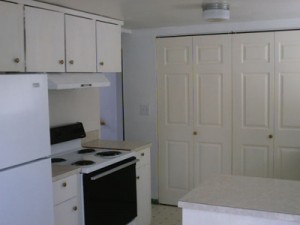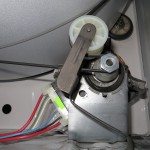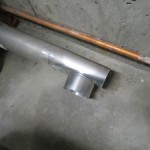How do you bring housing costs under control?
 I realize looking back on my more than 5o posts so far that many of them are about or related to real estate. That shouldn’t be a surprise, I suppose, since housing costs will be what drags you back into the working world if you’re not careful.
I realize looking back on my more than 5o posts so far that many of them are about or related to real estate. That shouldn’t be a surprise, I suppose, since housing costs will be what drags you back into the working world if you’re not careful.
Whether you rent or own your place, housing is likely eating up a good chunk of your monthly budget. The traditional rule of thumb for a mortgage, for example, is around a third of your income. They used to say 25% for renters, but I doubt that’s very realistic these days.
Even worse, as you head into a lower-income, but much happier, pretirement lifestyle, a surprise increase in your housing costs could crush your newly-found freedom.
I talked about this issue a bit in the old Pretired.org classic “Pop your own housing bubble“, but that was mainly about bringing your housing costs down in general, not as much about ensuring you keep control over expensive surprises.
There are a few common ways your housing costs could explode on you:
- Rent increase
- Interest rate increase if you have an adjustable rate mortgage
- Property tax increase
- Assessment or increase in HOA fees if you’re in a condo
- Sudden need to upgrade
- Remodeling or repairs
- Spike in utility costs
Obviously your housing costs are going to rise over the years if for no other reason than inflation and maintenance. The trick is to bring them under control so they’re not a worry. And that can mean some tough decisions as you prepare to leave the working world. (Or in my case, after.)
Let’s run through a few approaches to keeping your housing costs under control. If you have some additional thoughts to share, be sure to add them in the comments.
Buy a home
There are a lot of advantages to renting. Particularly if you’re young and working in an expensive area of the country, buying can be a big waste of money. However, if you’re beginning to look toward pretirement and are still renting, it can be worth considering a purchase.
For young people working in expensive cities, one idea is to buy a home where you think you eventually want to settle down. Keep that place rented while you’re working. When you’re ready to leave the corporate world, boot your renters and move into a hopefully paid-off house! It’s a great alternative to buying in an overpriced city. If you think you’d like to pretire to a vacation-oriented community, that’s an even better reason to buy-in early if you can.
In general, however, and especially for older folks, deciding to buy and reaching mortgage-freedom as soon as possible will lower your monthly costs, dramatically bringing pretirement that much closer. And more importantly you’ll remove the risks of rent increases and evictions so you don’t need to worry about suddenly finding more income.
One other advantage to buying is that an owned home can be rented if needed. That could take the form of renting a spare room or simply living in an apartment or with family while someone else pays you to live in your house. You may not ever want to make that move, but it’s nice to know it’s there if you need it. In our case, we have considered living overseas for awhile at some point. The rent from our home here would easily cover our rent nearly anywhere else in the world and in some areas would cover our entire living expenses.
Control rent increases
If you’ve decided to remain a renter, there are still some ways to keep rent increases somewhat at bay. Now the first thing flashing through everyone’s mind is to sign a long-term lease. That can protect you to some extent, but it has some obvious downsides (although I burned two landlords back in my renting days so being locked into a lease isn’t as scary as you might think — it’s mostly there to protect the renter).
But there are some other options available to you. If possible, it can be worth finding a city with some rent controls in place. That will at least put you in a situation of gradual rent increases, vs. steep, sudden increases.
Additionally, I’d recommend looking for a landlord that isn’t part of a big rental management firm. These firms are incented to increase rents year after year and to keep up with the market. If someone moves out due to a rental increase, they actually are fine with it as they can go in and fix all the stuff you’ve been complaining about and then rent it for more money. In contrast, individuals who are renting out a spare home independently are often terrified of losing a good, reliable renter. It’s not unusual to find people who have been renting from the same people for decades with no rent increases. In addition, an independent landlord is very unlikely to pursue legal remedies if you walk away from your lease.
But all of that said, generally speaking I find renting a greater risk for a safe pretirement than buying.
Pay off your mortgage
Now obviously if you have a passive income source that covers your mortgage payment, you could say your housing costs are already under control. For example, if you’re one of those investing ninjas who keeps your home leveraged at a low interest rate so you can make a little extra margin in the market, you could argue you’re under control already. Unless, of course, your income source takes a hit. Say you’re a growth investor who has been averaging 6% in the market and have your house on a 30-year mortgage at 3%. Good for you! But, say we hit a big market downturn. Say it happens after your working career has ended. In effect your housing costs just shot upward. This is why I advocate paying off a mortgage, especially for anyone over 40. Getting rid of your mortgage just takes that risk off the table. Should you wish to remain leveraged to keep your pretirement fund growing as quickly as possible, I still recommend paying your mortgage down to a controlled amount, say $100,000 or so. This will help limit disaster if we hit an economic rough patch.
For some thoughts on how to pay off your mortgage quickly, see my old post on How to get rid of your mortgage.
Condo owners – watch out
I’ve never owned a condo so I don’t consider myself an expert in this area. That said, I have heard many (many!) horror stories over the years. Enough to where I think I have to add a few thoughts about condos here.
A quick note, first, however. Despite these unique risks of condos, they in some ways pale compared to the risks of owning a single family home — particularly in repairs and improvements. For every sudden $30,000 assessment there are 10 stories of surprise roof replacements. In return the smaller size and limited things to remodel have a natural built-in cost control component.
So as we all know, the two biggest surprises (if there are any others, let me know) to come along related to condos are increases in monthly dues and surprise assessments. I don’t know of any magical ways to avoid these once they occur, but by doing your homework before you buy, you can avoid some of these. I don’t think it makes a lot of sense to buy into one condo over another because the HOA fees are a bit lower. Low fees could mean the condo isn’t keeping up with maintenance which could in turn trigger an assessment. Look for reasonable, mid-range fees and a very well-maintained building. Most condo buyers only have their own unit inspected, but I’d see if I could get my home inspector to walk around the property a bit and look for potential big problems. Failing siding, decks or windows or just a general look of disrepair.
Remember that with real estate, what seems cheap can be very expensive! Buy quality, do your homework and you’ll be fine. Oh, and you may want to maintain a slightly larger emergency fund just in case.
Property taxes – ugh
Here in Washington state, we have an odd taxing structure. It’s a super screwed-up approach to taxation that keeps placing us on top of lists of most regressively taxed states, despite our being one of the most liberal states. This is because we stupidly have no income tax. Since our blissful liberal population wants to take care of its people and infrastructure, it forces governments to lean heavily on the only tax mechanisms available to them: sales taxes and property taxes (and fees such as car licensing and tolls, but that’s a minor issue). Anyway, the point of this is that not only are our property taxes super high, they are also continually going up. My half of our monthly property taxes is $220 — that is by far my largest monthly expense!
As long as I stay living here, my options for controlling this expense are fairly limited — thank goodness I don’t have a mortgage payment to make every month on top of that! I could challenge my assessed property value but that would have a tiny impact even if I won. No, unfortunately my best bet is to move. To a cheaper property and potentially to a place without such a high property tax. If we decide not to move, then I need to do some rough math on how much this expense is likely to grow (apply historical percentage increases forward, for example) and make sure my pretirement plan accounts for that.
Buy the right house for your needs
In Pop your own housing bubble, I wrote about how important it is to think about what you NEED vs. what you can afford. But beyond simply lowering your housing costs, it’s important to think about what life changes you might experience so you buy something that fits those needs. There are a few things that can happen in life that could drive a surprise expense. The most obvious, of course, is children. If you’re a pretirement over-achiever and put off having kids until you were financially independent, my hat is off to you. But you could end up rushing back to the warm embrace of a corporate job if you forgot to buy a home that was kid-ready. Even though your career was “ended” you might find yourself in need of a house that costs $100,000 more than what you’ve got today. Another, not as happy, example is thinking about aging. My inadvertent house flip had a major flaw: 20+ steps to the front door from where you park. Living pretired in a house like that could leave you in major trouble should age or an accident leave you unable to get to your own front door without help. Or the issue could simply be one of distance from work or the grocery store. Think about these issues early so you don’t get caught.
Remodeling, repairs and other risks
Fixing up houses is an addiction. It’s an addiction I have struggled with most of my adult life. I wish I could say I’m a recovering remodeler, but unfortunately my basement tells a different story. So I know very well that houses are often nothing more than rickety boxes you fill with your life savings. So what can you do?
First of all, try to buy something that doesn’t need a lot of work — especially if you’re 40 or older. Save the big mistakes for the young people!
Next, do fix things that need fixing — and fix them early and do it right. The clearest example I can think of is your roof. Before you quit your job for good, maybe you go ahead and spend the money on the roof replacement you’ve been putting off. Spring for a little higher quality and you might not ever need to touch it again.
Similarly with “nice-to-haves” — an updated kitchen, say — take care of these projects before you move into pretirement. You’ll want to live for a long time without an expensive project, so get it done early and do it right so you don’t have to come back to it later.
Bottom line: make a list of these potential timebombs early and attack them one-by-one before you pretire so you’re not caught scrambling later on.
Spend money to get utility costs under control early
I hate telling you to spend money, but utility costs are another area that can bite you if you’re not careful. If you lived through the 1970s like I did, you know what an energy shock feels like. We North Americans tend to get pretty complacent about energy when it’s cheap, like it is today. But regardless of when you think the next big surprise will happen, I think we can all agree on one thing: it will happen rapidly.
The thing about energy is that it’s such a commodity that when a ripple goes through the system, the speculators inevitably rush in to snag their share of the profit. So you see sudden, shocking spikes in cost. Should we have a sudden water crisis, the impact could be even more devastating. Those of you living areas of the country that are susceptible to drought or communities that live near where they’re poisoning the water sources by fracking really need to watch out for this.
If you’re still working, this is an issue, but not necessarily a life-altering one. If you’re pretired and need to keep expenses under tight control, this could be devastating. Your approach to controlling your utility costs will vary a lot by area of the country and type of house. But here are a few ideas to think about:
- Drop your electricity use to the bare minimum. Swap out all light bulbs for LEDs, use a clothesline instead of a dryer, be very careful about leaving anything turned on unnecessarily. You can use a Kill-a-Watt
 device to measure the electrical usage of individual appliances and pinpoint where you can save. You might even find that upgrading your refrigerator or other appliance could make financial sense.
device to measure the electrical usage of individual appliances and pinpoint where you can save. You might even find that upgrading your refrigerator or other appliance could make financial sense.
- Consider home power generation. I’m dying to do this, but since we may not be staying here long-term, I’m holding off for now. The price of solar panels has been dropping rapidly and it makes a lot of sense to install your own panels now. If you wait a couple years longer, it may be idiotic to not do this (assuming your house gets some sun). Small wind is another great way to generate power at home. The two approaches together work quite well as wind tends to kick up when the sun isn’t shining.
- Manage your heating and cooling costs tightly. We upgraded our furnace to natural gas (over the original 50-year old oil furnace) a couple years ago. I estimated it’d take around three years to break even, but more importantly to me was that the ongoing cost was lower and the added efficiency would help us avoid sudden expenses. We also have portable electric heaters that can be placed in bedrooms for an added boost or as a substitute should natural gas skyrocket.
- Manage your water smartly. Very similar to electricity, managing your water usage tightly so you can get by on the bare minimum could be essential if water rates skyrocket. Showers and toilets are probably the first places to look.
I also like the idea of storing water on-site. You condo people are kinda screwed, but you should at least have some emergency storage containers available. For those of you living in single family homes, though, installing some cisterns on-site can be pretty smart. I’ll only do this if I decide we’re definitely staying here, but it can make some smart sense, especially if you garden. I really like the idea of having enough water to get us through the summer, say 300 gallons or so. It’d be perfect for watering your garden or for emergencies. But in times of water rate spikes, you could even use this water for flushing toilets and cleaning if needed.
Well, that’s a pretty long list of things to think about already. I’m sure there are many other ways to control housing costs that I didn’t mention here. Just remember, housing is typically the largest expense in your life — bring it under control to ensure that once you’ve pretired you can stay pretired.
Let me know what you think are the most important ways to bring your housing costs under control in the comments!










